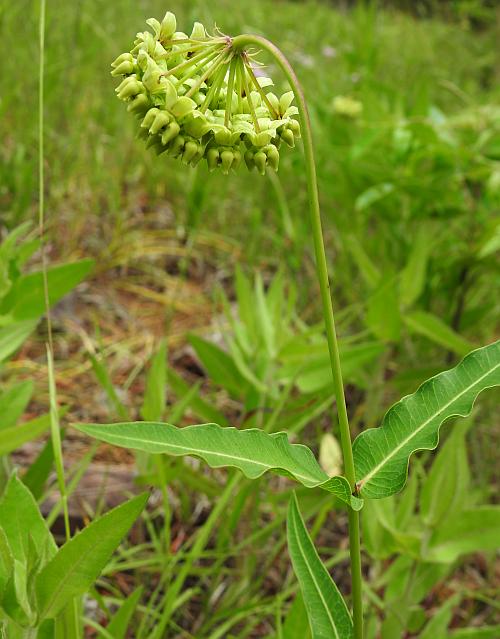Asclepias meadii Torr. ex A. Gray
Mead's Milkweed

Native
CC = 10
CW = 5
MOC = 12
SRank = S2
GRank = G2
© KBildner
Asclepias meadii Torr. ex A. GrayMead's Milkweed | |
 |
Native CC = 10 CW = 5 MOC = 12 SRank = S2 GRank = G2 |
© KBildner |
|
Family - Asclepiadaceae Habit - Rhizomatous perennial forb. Stems - Ascending to erect, to 50 cm, glabrous, glaucous, unbranched, with 2-5 nodes.
Leaves - Opposite, sessile, lanceolate, entire, spreading, to 8 cm long, 5 cm broad, glabrous (margins sometimes ciliate), lanceolate to ovate, bases rounded, sharply pointed, sometimes with a slightly wavy margin.
Inflorescence - Single terminal umbel, long-stalked, nodding, with 8-20 flowers. Pedicels to 2 cm long, typically pubescent.
Flowers - Calyx lobes 5, reflexed, sparsely to moderately short-hairy, 2.5-4.0 mm long, lanceolate to ovate. Corolla lobes 5, reflexed, glabrous, white to pale green, the lobes 9-12 mm long, lanceolate to oblong- lanceolate. Gynostegium appearing short-stalked (the column visible below the bases of the hoods), pale cream-colored to pale green, occasionally tinged with purple, the corona conspicuously longer than the tip of the anther/stigma head. Corona hoods 4.0-5.5 mm long, erect, attached near their bases, ovate to broadly ovate in outline, the tip rounded to broadly rounded, the margins with a pair of blunt, triangular teeth near the middle, the bases pouched. Horns attached toward the hood bases, relatively short, curved inward over the anther/stigma head and not extended past the tips of the hoods, sickle-shaped, relatively stout, not flattened, tapered to a sharp point at the tip.
Fruits - Follicles 8-10 cm long, erect or ascending from deflexed stalks, narrowly lanceolate to narrowly elliptic in outline, the surface smooth, minutely hairy. Seeds with the body 5-7 mm long, the margins narrowly winged, the terminal tuft of hairs white. Flowering - May - June. Habitat - Prairies and glades. Origin - Native to the U.S. Lookalikes - None close. Slightly resembles A. viridiflora. Other info. - This little species is rare in Missouri and is an endangered species in North America. It has become extirpated from much of its historical range due to habitat destruction, and many remaining populations continue to decline. Currently its global range comprises just a few Midwestern U.S. states, and nowhere is it common. Prairie management by means of haying has been shown to be detrimental to populations of Mead's milkweed. Apparently the timing of mowing in the past has not allowed plants to mature their fruits, resulting in populations becoming genetically depauperate from lack of sexual reproduction. However, populations respond positively to properly timed burns, and managers of areas where the species is known to exist have begun adjusting management strategies to attempt to rescue this critically imperilled species. Photographs taken at Taum Sauk Mountain, MO., 6-1-03 (DETenaglia); also on 6-7-2021 (KBildner). |